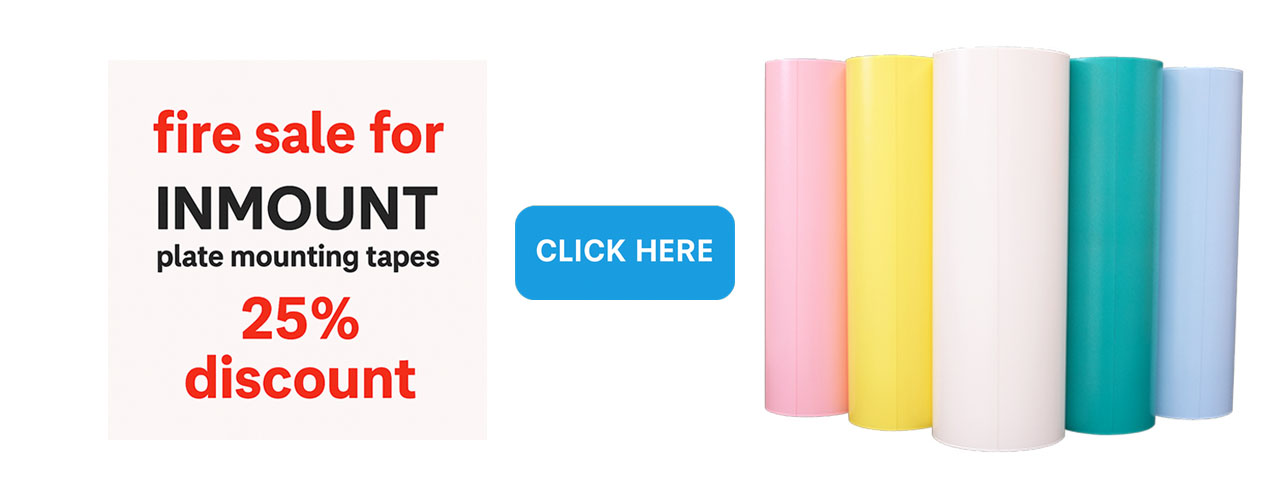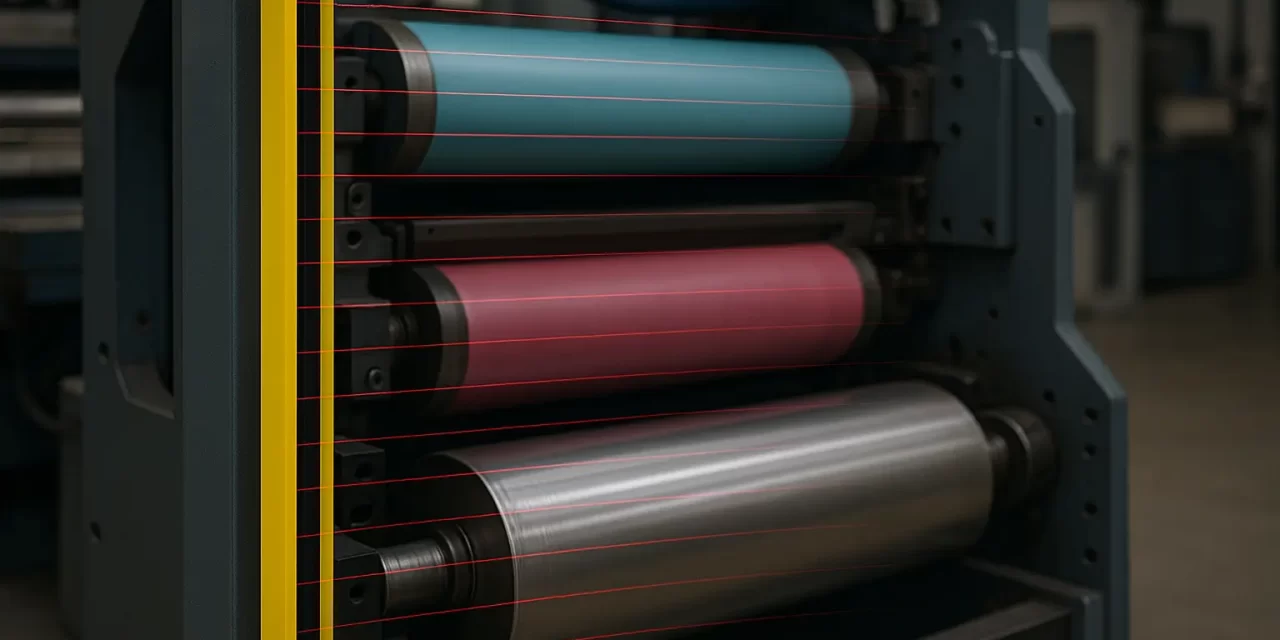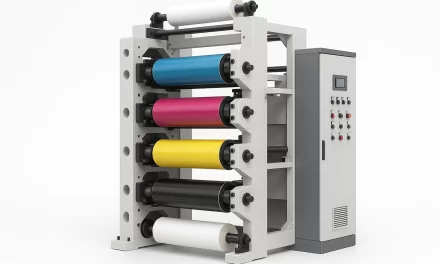Light Curtains in Flexographic Printing: Enhancing Safety with Smart Sensing Technology
In the fast-paced, precision-driven world of flexographic printing, safety and productivity must go hand-in-hand. With machines running at high speeds and operators constantly interacting with moving parts, the potential for injury is ever-present. That’s why light curtains have become an increasingly popular safety solution in modern pressrooms. These smart, non-contact devices act as invisible safety nets, stopping machinery the moment an unsafe action occurs—without disrupting workflow or accessibility.
Light curtains are not just safety tools; they are enablers of modern production efficiency. In a landscape where print runs are getting shorter, setups faster, and customization more frequent, traditional mechanical guards can slow things down. Light curtains provide the best of both worlds—maximum operator protection and unrestricted machine access.
In this article, we’ll explore how light curtains work, their role in flexographic printing, benefits over traditional guards, integration best practices, and the future of light-based safety systems.
What Are Light Curtains?
A light curtain is an optoelectronic safety device that creates an invisible barrier using infrared light beams. It typically consists of:
- An emitter unit, which sends out multiple parallel light beams
- A receiver unit, which detects the beams
- A safety control unit, which monitors beam interruption and sends stop signals
When an object (like a hand, arm, or tool) breaks any of the beams, the system instantly sends a signal to halt machine movement—preventing potential injury or equipment damage.
Unlike physical guards, light curtains don’t obstruct the view or workflow, making them ideal for applications requiring frequent human access to hazardous zones, such as the die cutting area, plate mounting sections, or web threading points in a flexo press.
Why Light Curtains Matter in Flexographic Printing
Flexographic printing presses involve numerous high-risk zones—rotating cylinders, tensioned web paths, UV curing units, and die stations. Operators must routinely access these areas during setup, adjustments, or material changes.
Light curtains address a crucial need in these scenarios: real-time, non-contact safety. Here’s why they are becoming standard in forward-thinking flexo pressrooms:
1. Operator Safety Without Physical Barriers
Operators can access the machine for setup or monitoring without needing to open or remove fixed guards. The moment a limb enters a hazardous zone, the machine halts.
2. Fast, Automated Response
Light curtains react in milliseconds—faster than any human could press an emergency stop. This minimizes the risk of injury during unexpected movements or accidental reach-ins.
3. Workflow-Friendly
Because they don’t physically block the machine, light curtains allow for faster setups, better visibility, and fewer obstructions during operation.
4. Compliance Assurance
Many national and international safety standards, including OSHA, ANSI, and CE requirements, recognize light curtains as valid safety measures. Properly installed, they help achieve safety compliance effortlessly.
5. Compatibility with Modern Press Designs
With servo-driven automation and smart integration, light curtains fit seamlessly into new-generation flexo presses and retrofits for older machines alike.
How Light Curtains Work: A Quick Breakdown
- Setup: The emitter and receiver are mounted on opposite sides of a hazardous zone, such as the die-cutting module or unwind station.
- Beam Alignment: Multiple invisible beams of infrared light are projected from emitter to receiver, forming a protective “curtain.”
- Monitoring: The safety control system monitors whether all beams are received continuously.
- Interruption Detection: If any beam is interrupted—by a hand, finger, or object—the system immediately interprets it as a safety breach.
- Machine Stop: A signal is sent to the press control system to halt the machine’s motion instantly.
Some advanced light curtains even allow for muting zones, where certain beams can be temporarily disabled (e.g., when materials pass through without triggering a stop), enhancing operational flexibility.
Common Light Curtain Applications in Flexo
Light curtains can be used throughout a flexographic press, particularly in areas where fast access and safety intersect:
- Die cutting stations – Where rotating dies present cut and crush hazards
- Unwind/Rewind areas – Where operators frequently handle rolls under tension
- Plate mounting zones – Where close inspection and adjustments are needed
- Laminating and slitting units – With multiple sharp and rotating components
- Web break zones – Where operators need to clear or rethread the substrate
- In-feed and out-feed conveyors – To protect from pinch points and automated loaders
With careful integration, light curtains can provide zone-based protection, offering coverage across multiple sections of a press without requiring excessive guarding or operator input.
Types of Light Curtains Used in Printing
Depending on the application, different models and configurations are available:
Finger Protection Light Curtains
- High resolution (down to 14mm)
- Detects small objects like fingers
- Ideal for areas with very close operator interaction
Hand Protection Light Curtains
- Resolution around 30mm
- Detects hands or larger objects
- Suitable for wider access zones
Body Detection Systems
- Wider beam spacing (up to 70mm)
- Designed to detect full body entry into hazardous areas
Muting Light Curtains
- Temporarily suppress beams in predefined areas
- Allows material to move through without triggering a stop
Advantages of Light Curtains Over Traditional Guards
| Feature | Light Curtains | Mechanical Guards |
|---|---|---|
| Access Time | Instant | Requires unlocking/removal |
| Visibility | Clear view of work area | Often obstructed |
| Reaction Speed | Milliseconds | Human-dependent |
| Setup Flexibility | Easy to reconfigure | Fixed and rigid |
| Space-Saving | No physical obstruction | Requires swing/slide space |
| Automation Integration | High | Low |
By minimizing setup and access delays, light curtains can even increase press productivity, especially in short-run, multi-job environments.
Best Practices for Installing Light Curtains
1. Risk Assessment
Start with a safety audit to identify high-risk areas. Consider operator behavior, press speed, and typical workflows.
2. Proper Positioning
Mount curtains close enough to protect the zone but far enough to stop the press before contact is made. This is known as the safety distance.
3. Avoid Blind Spots
Ensure the curtain covers the full width and height of the hazard zone. Use mirrors or additional units for irregular layouts.
4. Test Regularly
Include beam testing in your preventive maintenance schedule. Faulty sensors can lead to non-compliance or accidents.
5. Integrate with Safety PLCs
Ensure the curtain communicates with the machine’s programmable safety controller for faster, more reliable shutdown responses.
Maintenance Tips for Light Curtains
- Keep the lenses clean—Dust or ink mist can block beams and cause false trips. Use lint-free cloths and gentle solvents.
- Check beam alignment regularly—misalignment can result in unwanted downtime or compromised protection.
- Test E-stop functionality—confirm the press halts completely and promptly when a beam is interrupted.
- Monitor status LEDs—use indicator lights to check curtain health and beam continuity.
- Log inspections—Maintain records for audits and compliance tracking.
Future Trends in Light Curtain Technology
As Industry 4.0 transforms pressrooms, light curtains are becoming smarter and more integrated:
- Wireless light curtains reduce cabling complexity and improve install speed.
- Cloud-connected safety analytics allow remote performance monitoring.
- Self-diagnosing curtains with predictive alerts for maintenance needs.
- AI-powered vision systems working alongside light curtains for advanced safety verification.
- Smart muting logic to adapt beam behavior based on job parameters or operator credentials.
In the future, expect light curtains to become part of a holistic press safety ecosystem, where automation, machine learning, and human-centric design converge.
Conclusion
In the relentless pursuit of productivity, we must never compromise safety. Light curtains in flexographic printing offer the rare ability to protect people without slowing processes—an innovation that truly aligns with modern pressroom goals.
By integrating light curtains into your safety system, you’re not just installing sensors—you’re building trust, accountability, and resilience into your operations. Operators feel safer, workflows become smoother, and compliance becomes effortless.
In a world where downtime is costly and safety is priceless, light curtains aren’t just the right move—they’re a smart one.






